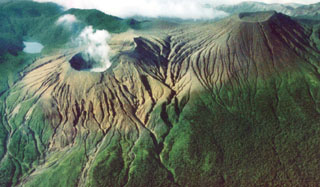Report on Rincon de la Vieja (Costa Rica) — April 1994
Bulletin of the Global Volcanism Network, vol. 19, no. 4 (April 1994)
Managing Editor: Richard Wunderman.
Rincon de la Vieja (Costa Rica) Decreased seismicity
Please cite this report as:
Global Volcanism Program, 1994. Report on Rincon de la Vieja (Costa Rica) (Wunderman, R., ed.). Bulletin of the Global Volcanism Network, 19:4. Smithsonian Institution. https://doi.org/10.5479/si.GVP.BGVN199404-345020
Rincon de la Vieja
Costa Rica
10.8314°N, 85.3364°W; summit elev. 1729 m
All times are local (unless otherwise noted)
During April, the local seismic station received only 13 low-frequency events. In contrast, there were 283 low-frequency events during the previous month, the most so far this year. Neither the increase nor the decrease in seismicity were associated with any other observed changes.
Geological Summary. Rincón de la Vieja is a volcanic complex in the Guanacaste Range of NW Costa Rica. Sometimes referred to as the Rincon de la Vieja-Santa María Volcanic Complex, it consists of a slightly arcuate 20-km-long ridge of 12 craters and pyroclastic cones constructed within the 15-km-wide early Pleistocene Guachipelín caldera, whose rim is exposed on the south side. Sometimes known as the "Colossus of Guanacaste," it has an estimated volume of 130 km3 and contains at least nine major eruptive centers. The Santa María cone, the highest peak of the complex, is located on the E side of the ridge and has a lake within the 400-m-diameter crater. A Plinian eruption producing the 0.25 km3 Río Blanca tephra about 3,500 years ago was the last major magmatic eruption. All subsequent eruptions, including numerous reported eruptions possibly dating back to the 16th century, have been from the active crater, near the center of the complex, with an acidic 300-m-diameter lake.
Information Contacts: E. Fernández, J. Barquero, V. Barboza, and W. Jiménez, OVSICORI; G. Soto, Guillermo E. Alvarado, and Francisco (Chico) Arias, ICE; Héctor (Chopo) Flores, Univ. de Costa Rica.

